Outforia Summary: Key Takeaways
- There are more than 50 lizard species in Florida, with only 15 of those being native to the state.
- No known venomous or poisonous lizard species are found in Florida.
- The most dangerous lizards in Florida are invasive species, such as the Cuban Knight Anole, Green Iguana, Argentine Black and White Tegu, Tokay Gecko, and Nile Monitor.
- Although these lizards may be aggressive or have a powerful bite, they generally won’t attack humans unprovoked, and bites usually occur when people attempt to catch or handle them.
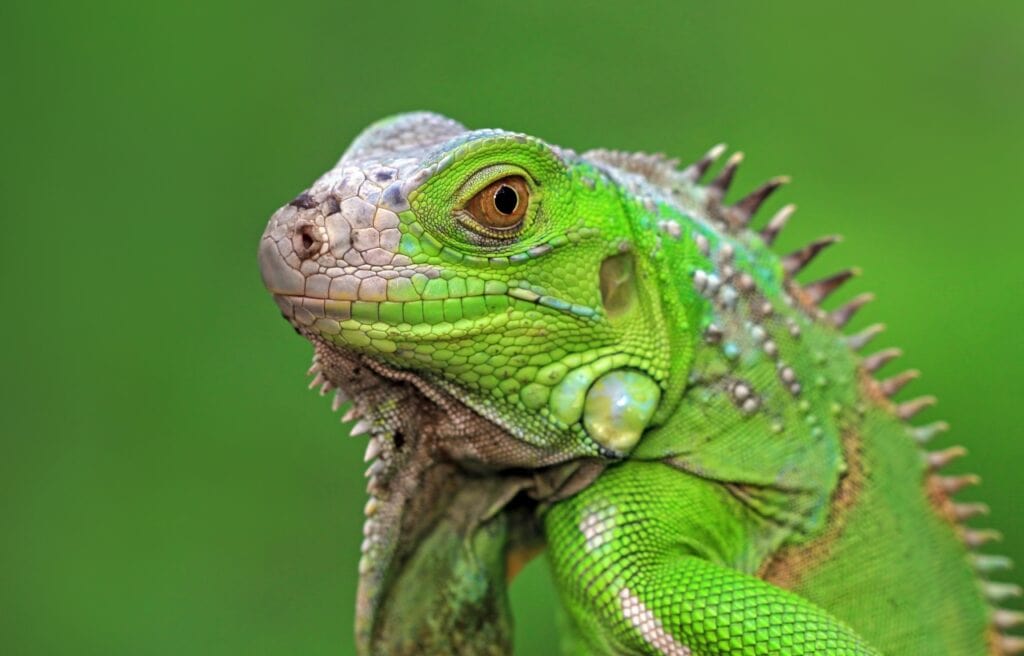
There are over 50 species of lizards living in Florida. Of those 50, only 15 are endemic to Florida.
The rest are invasive, most likely introduced through the booming exotic pet trade. And if you’ve ever been to Florida, you’ll know that lizards are everywhere.
Really, they’re everywhere! I recall taking trips to Florida when I was younger. Fresh off the plane, I would walk out of the airport and see lizards rushing around outside like passengers running to catch a flight.
Take a walk down any suburban street in Florida, and you’re bound to see some lizards, too. Green anoles scurry up palm trees; skinks rush through the grass; brown anoles bask on every mailbox. It’s a herpetophobe’s worst nightmare!
But do you have anything to fear from Florida’s reptilian residents? Are there any poisonous lizards in Florida? Do they attack humans, and if so, how bad are the attacks? In this article, we’re looking at some of the most dangerous lizards in the Sunshine State.
Venomous or Poisonous Lizards in Florida
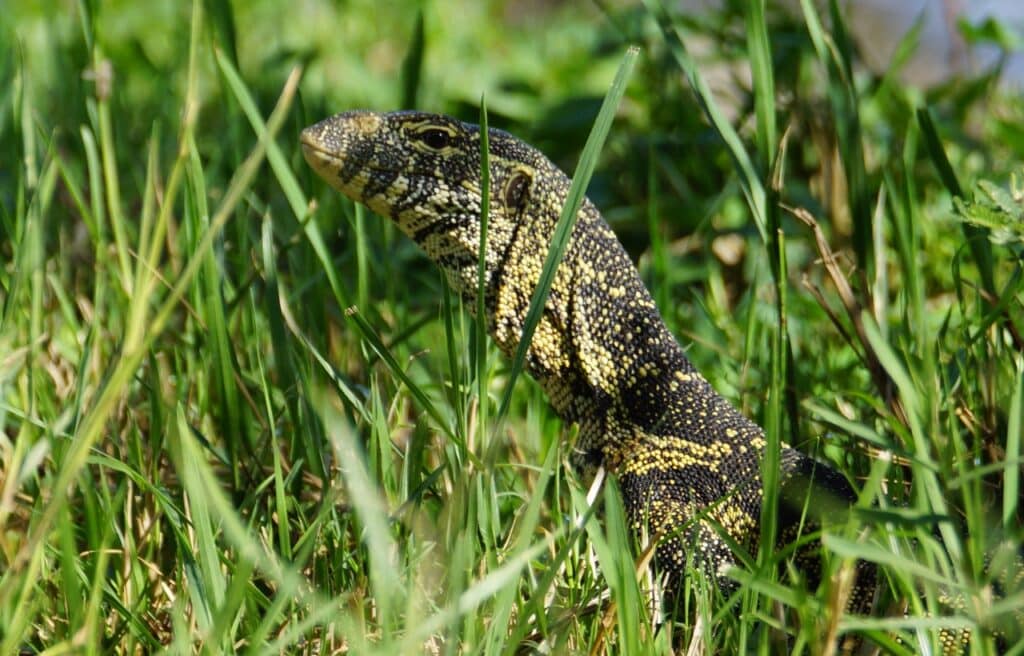
There are no known venomous or poisonous lizards in Florida. Snakes are a different story, but lizards none. And what’s the difference between venom and poison anyway?
Poison refers to any harmful substance that is ingested, inhaled, or absorbed through the skin. For example, monarch butterflies are poisonous because their toxins are only released when an animal eats them.
Conversely, venom is a harmful substance delivered to a victim via bite or sting. A rattlesnake is an example of a venomous animal because the venom is injected into prey when the rattlesnake bites.
North America is home to two venomous species of lizard, the gila monster and the Mexican bearded lizard. However, neither of these lizards live in Florida.
It should be noted that some lizards on this list, like the tegu, have bacteria in their saliva that can cause severe infection or illness. However, this isn’t considered venom.
But just because there are no poisonous or venomous lizards in Florida doesn’t mean there aren’t any dangerous ones. So now, let’s look at some of Florida’s most ferocious reptiles.
You might also like: The 25 Most Amazing Types Of Lizards (Names, Photos And More)
Cuban Knight Anole (Anolis equestris)
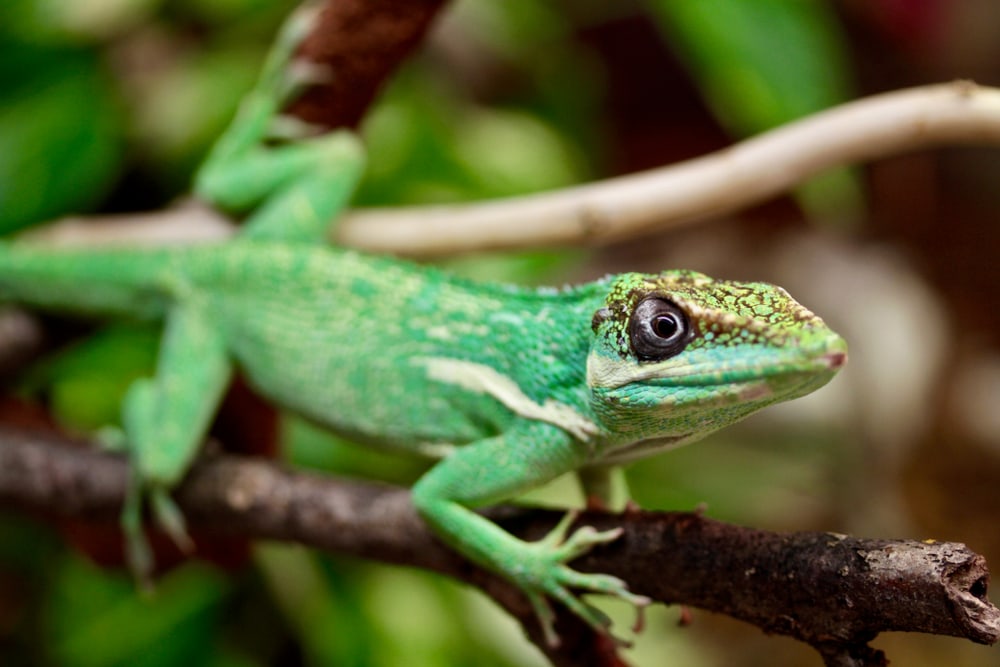
Native to Cuba, Knight anoles were introduced to Florida via the pet trade, where they now thrive.
Knight anoles are the largest anole species and can reach lengths between 13-20 inches (33 – 51 cm). They’re so large that they’re often mistaken for small iguanas!
Knight anoles are bright green, sometimes with yellow or white stripes beneath their eyes or on their shoulders. They have rather startling gray eyes and long, skinny tails. Male anoles also have red dewlaps under their chin, which they flash when attracting a mate or establishing territory.
Knight anoles are arboreal, meaning they live most of their lives in trees. They mainly eat insects but won’t pass up on eating a small lizard, bird, or rodent either.
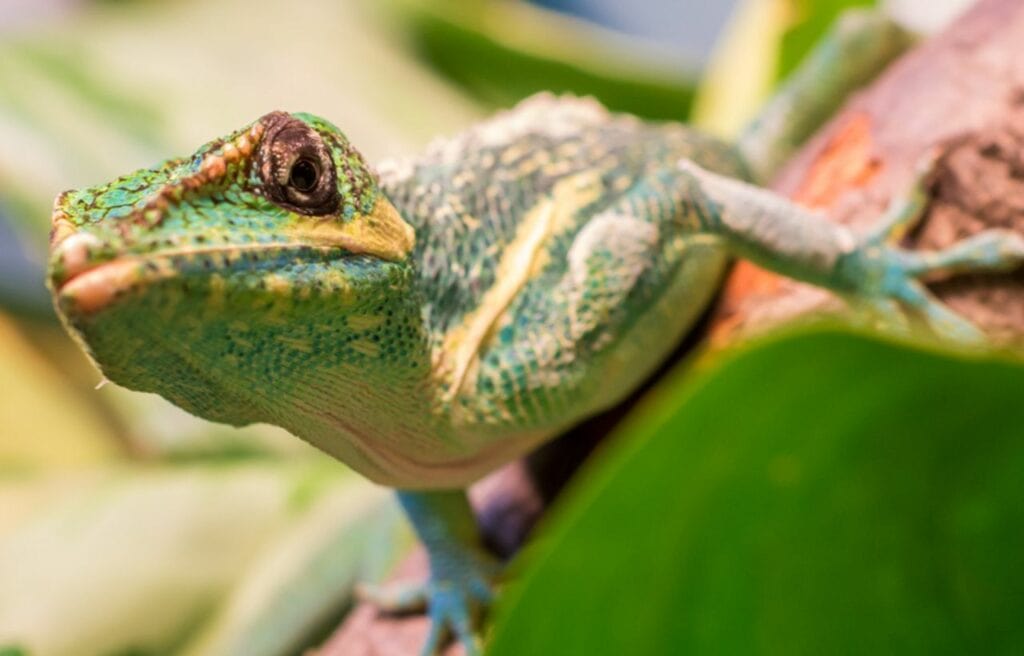
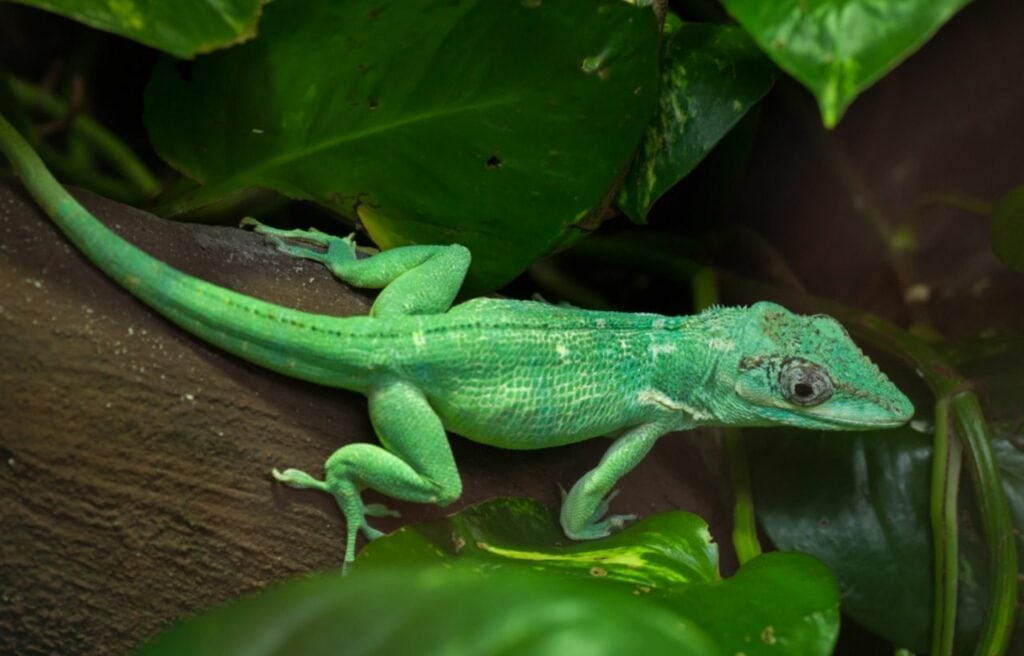
Knight anoles, like most lizards, have small, cone-like teeth. Their teeth are helpful when snatching up prey and crushing the exoskeletons of insects. They’re also quite sharp.
It’s probably best not to hold a knight anole. They’re known for their aggression when handled or disturbed. Even domestic knight anoles should not be handled because of their tendency to bite.
While not venomous, the bite of a knight anole is very painful. They also tend to hold on with their vice-like jaws when biting. By far, the risk of infection is the most dangerous part of an anoles bite.
If you’d like to learn more about the knight anole and see the power of their bite, check out this video:
Green Iguana (Iguana iguana)
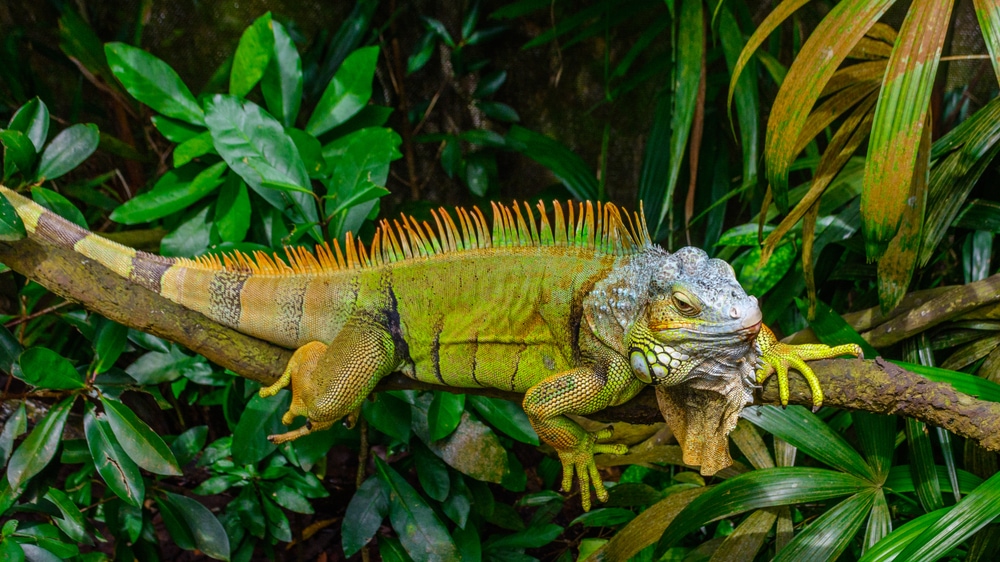
Like the knight anole, green iguanas aren’t native to Florida. Instead, they’re endemic to Central and South America, as far south as Paraguay and as far north as Mexico. Green iguanas were first reported in Florida in 1960 and are listed as an invasive species.
Green iguanas are one of the most giant lizards in the Americas. Males can reach lengths of over 5 feet and weigh anywhere from 11-20 lbs (4-9 kg)!
One reason they’re such popular pets is because of their striking appearance. They’re bright green, with occasional blue coloration, especially around the head. They have long toes with sharp claws; stretching along their spines are spikes used for defense and intimidation.
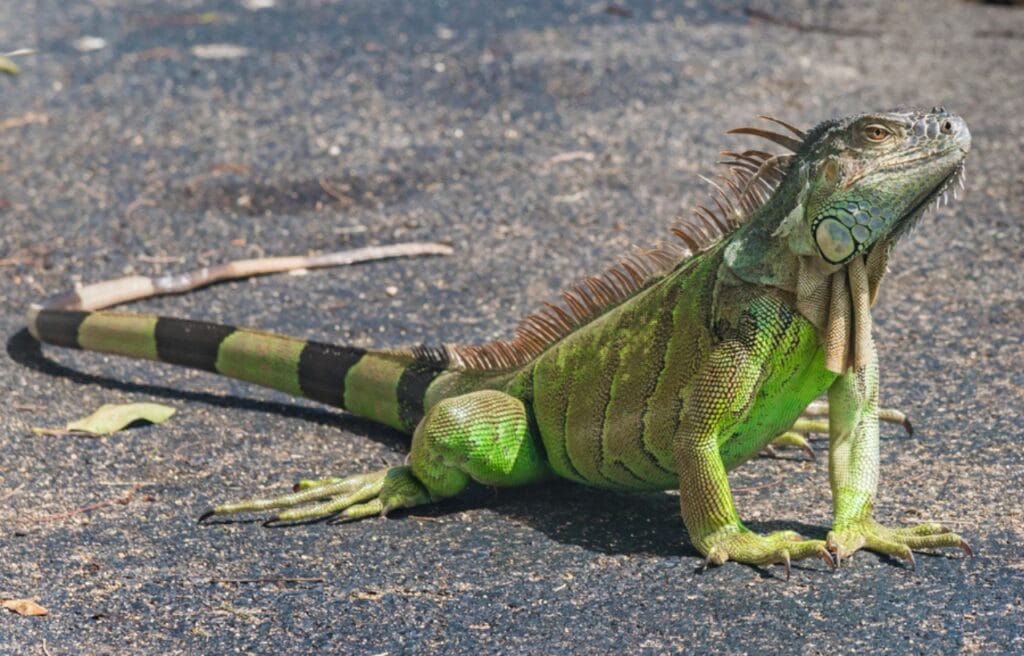
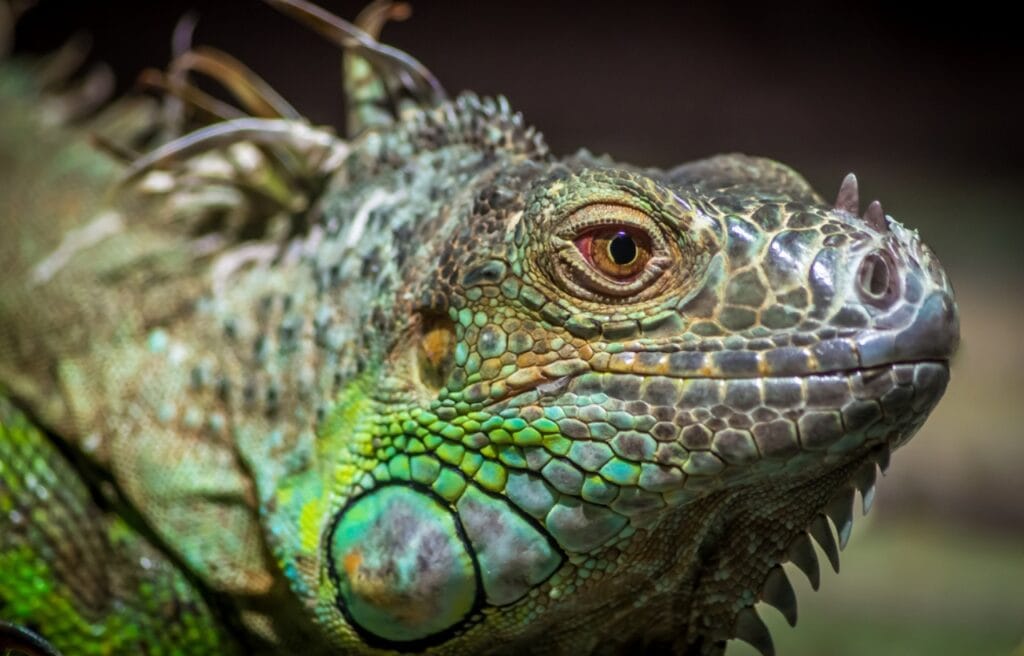
Herbivores by nature, the green iguana is a nuisance to homeowners, often tearing apart gardens in search of food. They also threaten native endangered tree snails, which they occasionally eat.
These giant lizards bite hard. Their teeth are designed for tearing into plant material, and their strong jaws exert considerable force.
Unlike the knight anole that bites once and clamps on, iguanas will bite multiple times and tear at what they’re biting. If that wasn’t bad enough, iguanas could carry salmonella in their saliva.
Argentine Black and White Tegu (Salvator merianae)
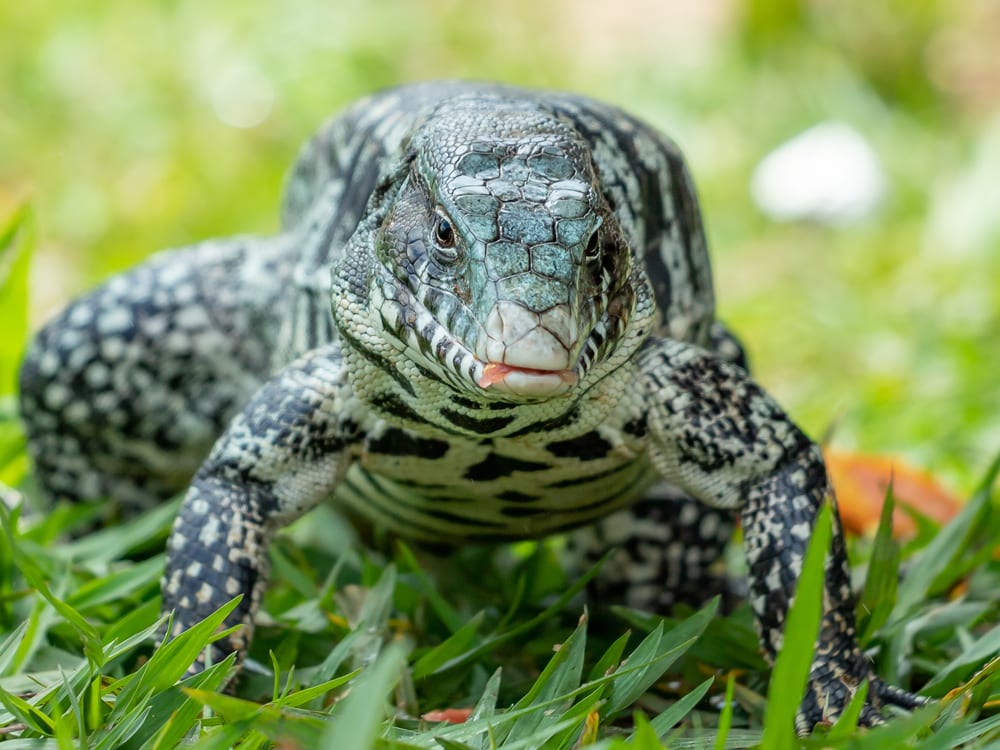
Another invasive species, who would have guessed? Black and White tegus are native to South America.
Like the knight anole and green iguana, tegus found their way into Florida through the exotic pet trade.
Around 2009, their population in Florida began to increase, and now their numbers are spiking. Some Florida counties have over 4,500 sightings in a single year.
Tegus are incredibly smart, and that’s part of the reason why they were so popular in the pet trade.
They can learn their names, follow commands, and even be house-trained. They’re like puppy dogs except less cuddly and more aggressive.
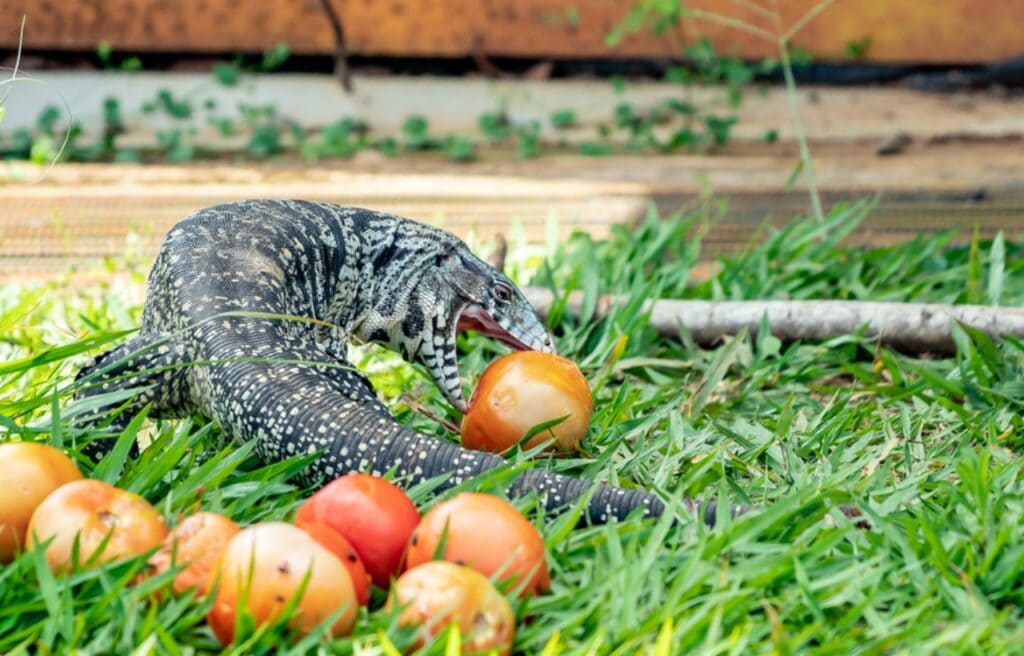

Tegus are slightly smaller than iguanas. Males usually reach lengths of 4 feet (1.2 m) and weigh around 10 lbs (4.5 kg). They can also live up to 20 years in the wild. Tegus are gorgeous lizards with bead-like scales in various black-and-white patterns.
Tegus are muscular and have incredibly powerful jaws, claws, and tails. However, their bite is the most dangerous.
Black and white tegus are incredibly damaging to Florida’s ecology. Tegus are omnivores but especially delight in eating eggs. They’ve been known to eat the eggs of turtles, lizards, and even alligators.
As one University of Florida publication puts it, “a growing and spreading tegu population may reduce populations of threatened and endangered native species such as crocodiles, sea turtles, ground-nesting birds, and the endemic Key Largo woodrat.”
Efforts have been made to control the Florida tegu population. However, tegus aren’t confined to the subtropical climates of southern Florida.
By burrowing underground, they can stand freezing temperatures, and now tegus have begun moving north into Georgia.
Tokay Gecko (Gekko gecko)
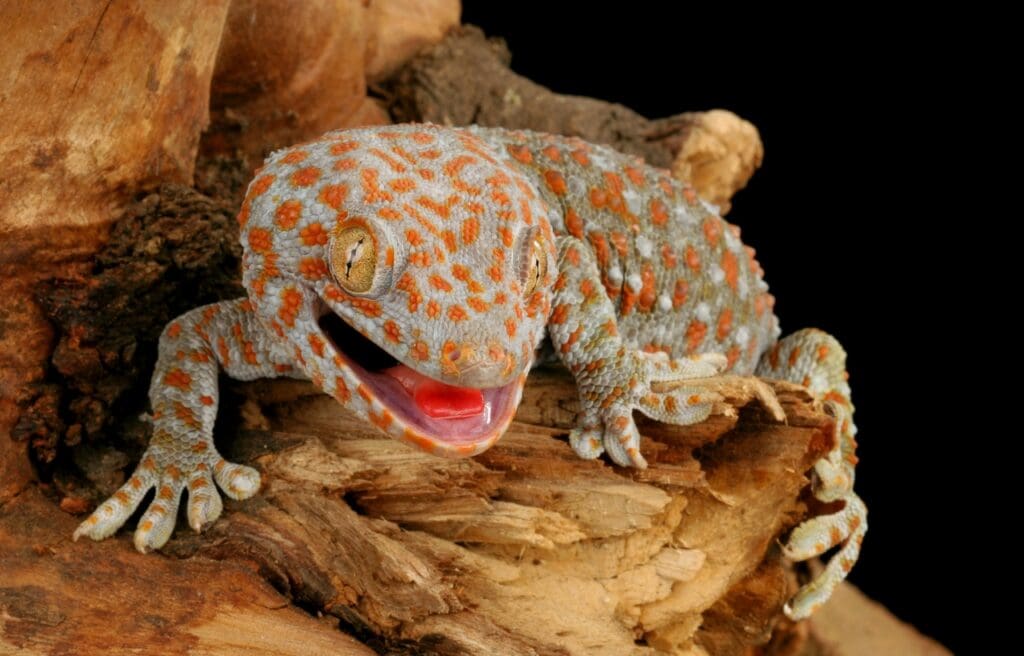
Like the other lizards on this list, the tokay gecko is an invasive species in Florida. The native range of tokay geckos is Asia and some Pacific Islands.
Tokay geckos are one of the largest geckos in the world, second only to the New Caledonian giant gecko (Rhacodactylus leachianus). They can reach lengths up to 14 inches (36 cm). Tokay geckos have bumpy, grayish-blue skin with orange spots dotting them.
But don’t let their beauty fool you; tokay geckos can bite hard! They’re known for their aggression. Even domestic tokays won’t hesitate to bite their owners.
Tokay geckos usually live in the trees or cliffs of their native rainforests. In Florida, however, they hang out in gardens, front porches, and bushes.
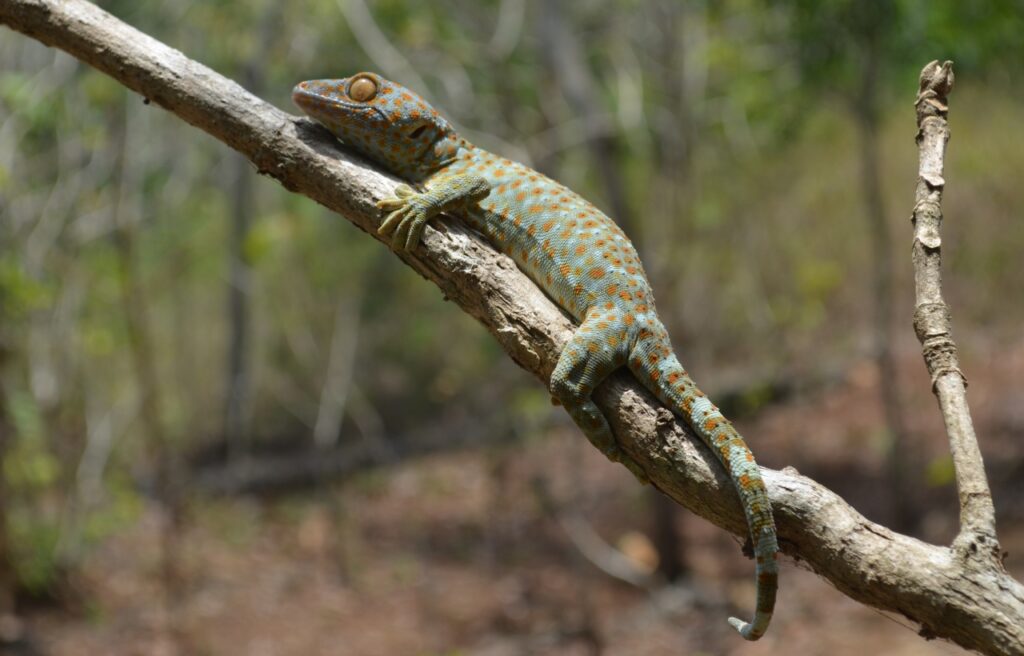
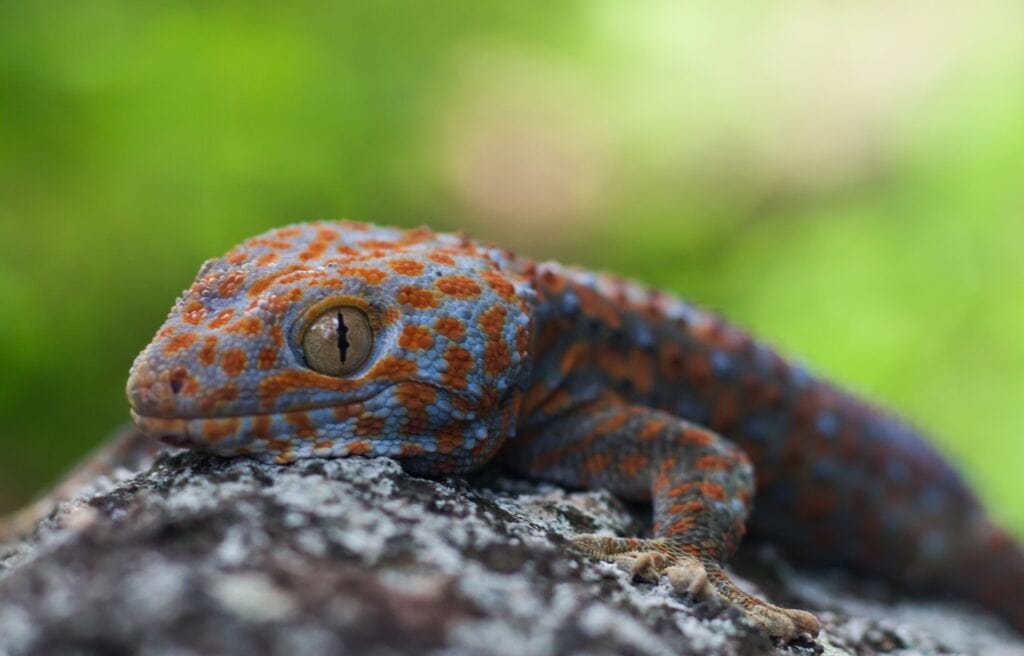
They’re nocturnal and usually prey upon bugs lured in by porch lights. Some homeowners like their company because they help prevent pesky bugs from swarming outside.
The tokay’s name is onomatopoeic, meaning its name is derived from the croaking sound the gecko makes.
Legend has it that American soldiers didn’t hear “tokay” during the Vietnam War but something else entirely. So, they nicknamed the gecko the “F— You Gecko,” believing it had a serious attitude problem.
If you want to hear what the lizard sounds like and judge for yourself what it’s saying, check out this video here:
Nile Monitor (Varanus niloticus)
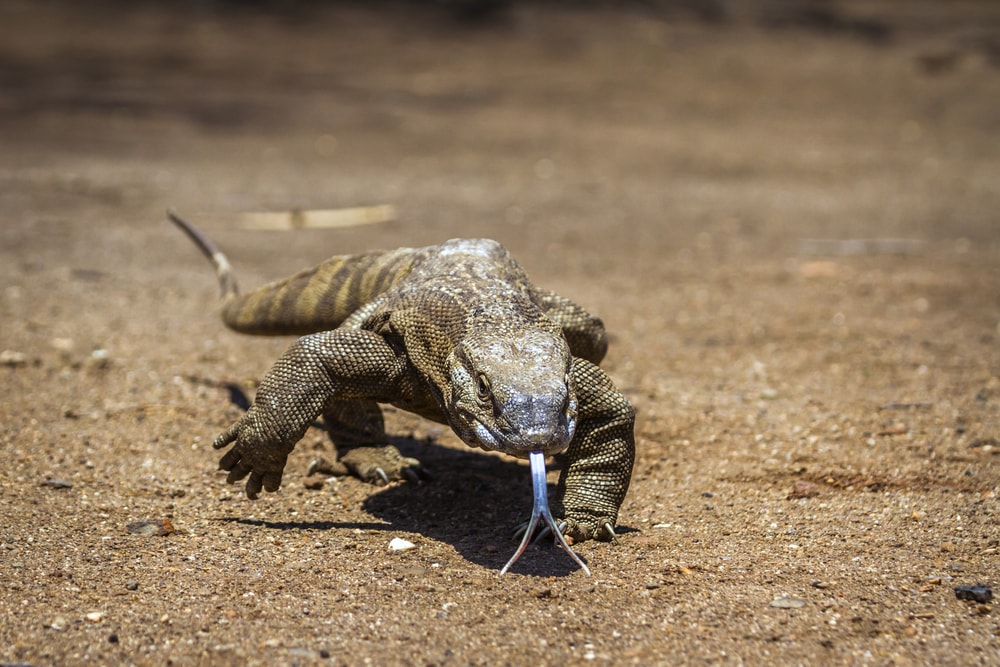
Native to Egypt, the nile monitor is one of the largest lizards on this list. Adult males can reach up to 9 feet (2.7 m) in length and weigh more than 30 lbs (13 kg). However, most max out at around 6 feet (1.8 m) in length.
Nile monitors are dark green to black in coloration, often with yellow or white spotting. They are semi-aquatic, and their long, thick tails help propel them through water.
Nile monitors are generalist eaters meaning they’ll eat just about anything they can catch. This makes them an especially problematic invasive species because they may harm a wide range of endangered animal populations.
For example, south Florida is home to the largest population of burrowing owls in the state. It’s also home to the largest population of nile monitors in the state. Monitors have been known to invade owl burrows and prey on eggs, hatchlings, and adult owls alike.
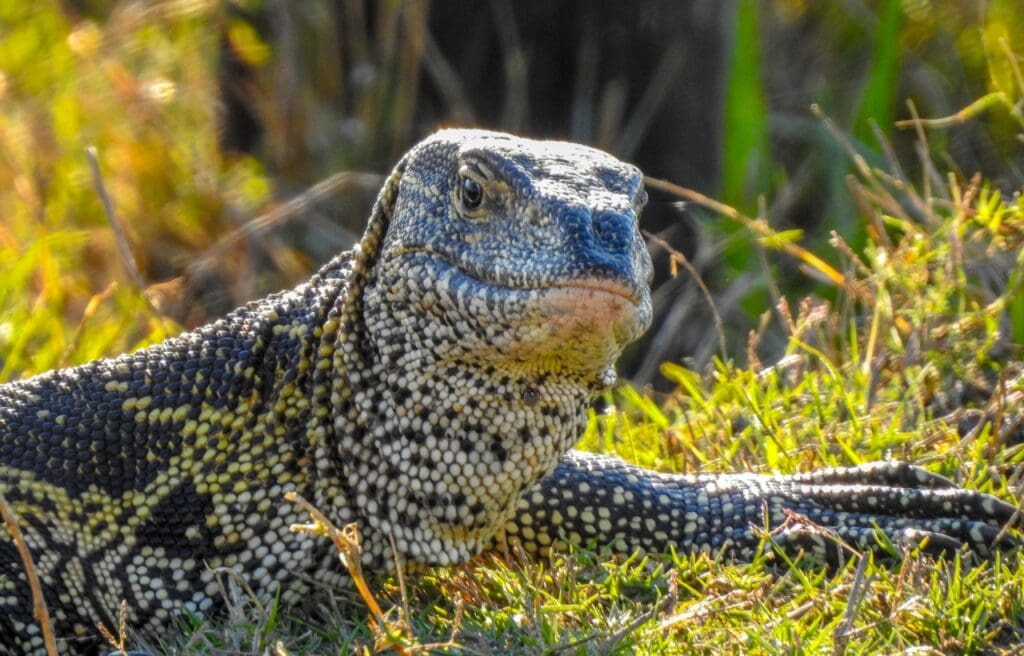
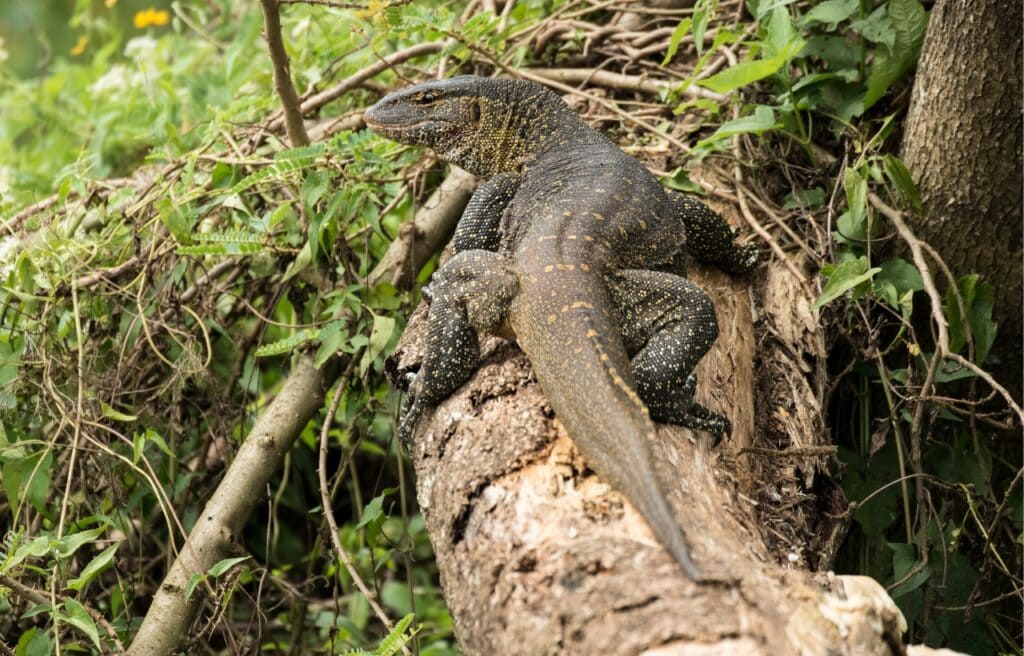
Nile monitors also pose a threat to sea turtles, as they will dig up sea turtle nests and eat the eggs. Not only that, but monitors are so fierce they also prey on young alligators.
Nile monitors are skilled swimmers, crawlers, and climbers. Because of this, Florida wildlife officials are concerned that their range may continue to spread throughout Florida.
If their range continues to spread, this may cause problems for people, especially in residential areas.
Unlike most of the other lizards on this list, nile monitors have been known to prey upon small pets and livestock. This makes them especially problematic for homeowners.
While there are few reported attacks from nile monitors, their powerful bite and strong tails makes them potentially dangerous. They can also be aggressive and temperamental.
You may also like: 30+ Types Of Amphibians: Identification Guide With Pictures + Facts
American Alligator (Alligator mississippiensis)
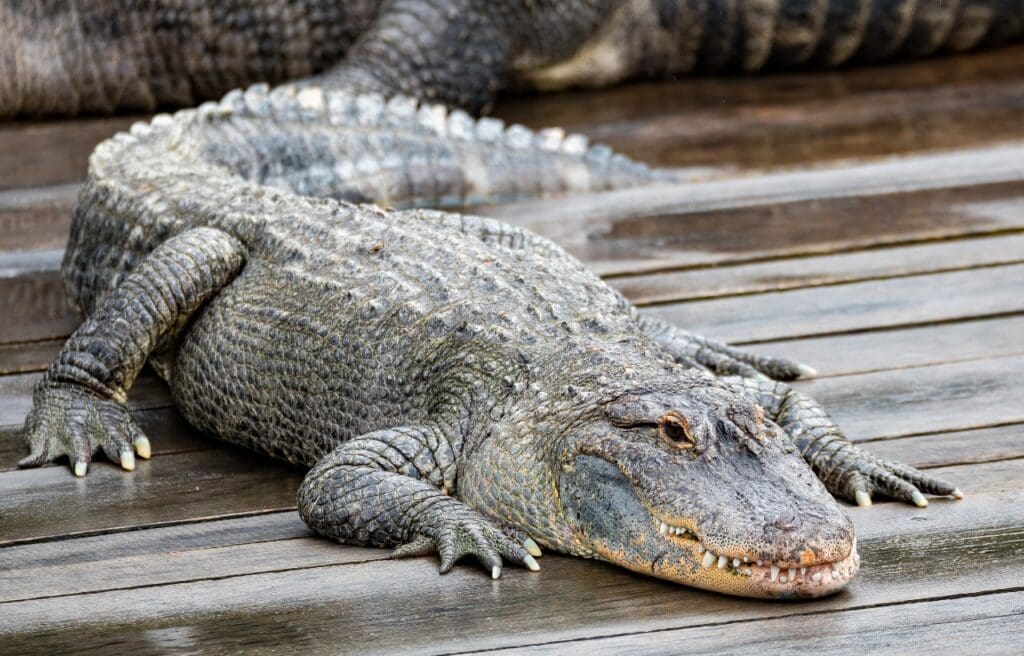
We’ve saved the most famous and most dangerous Florida reptile for last.
Unlike the other lizards on this list, the American alligator is native to Florida and not invasive.
These massive reptilians can grow more than 12 feet (3.7 m) long and weigh over 1,000 lbs (453 kg). They have thick, armor-like skin covered in large scales called scutes.
American alligators are strict carnivores. They eat fish, frogs, birds, and whatever mammals they can catch. They can even eat large prey like deer or wild hogs.
They are nocturnal hunters and drag large prey underwater to drown them before eating them.
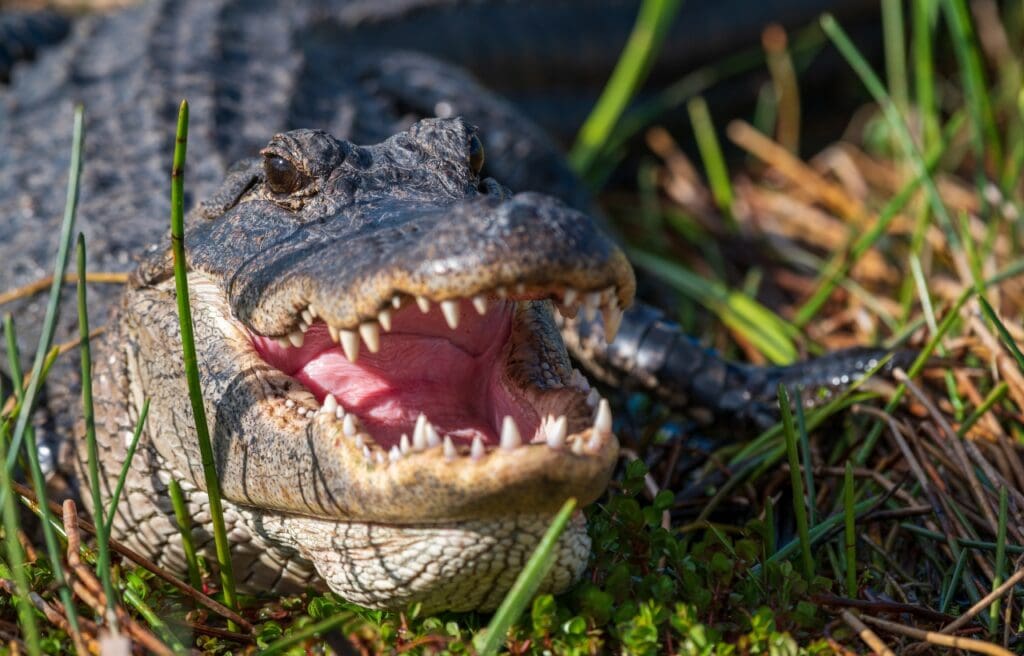
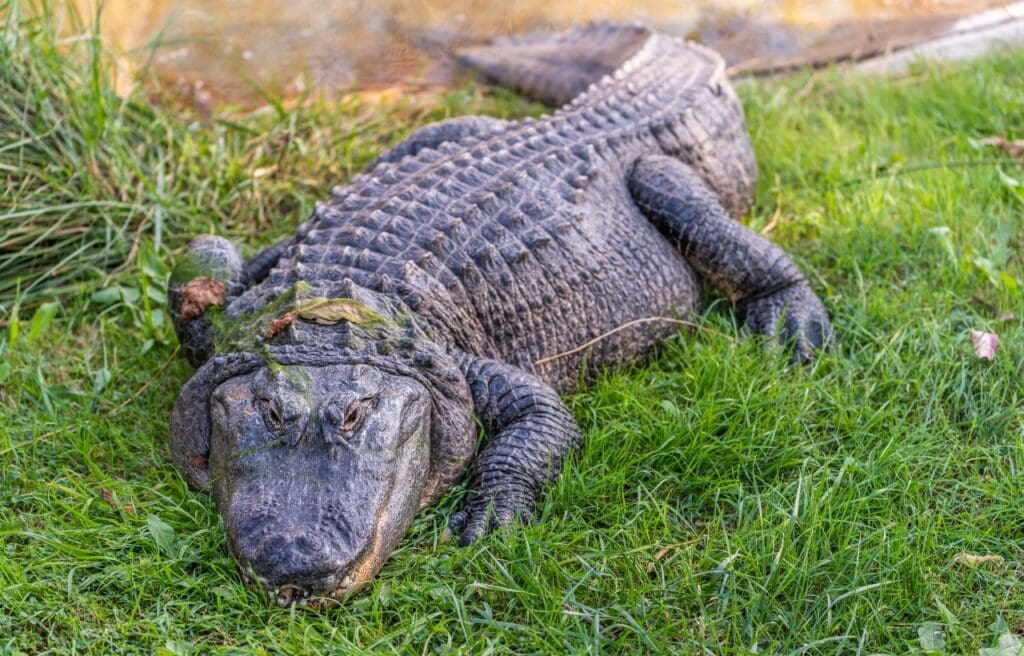
Unlike other lizards that have small, needle-like teeth, alligators have large teeth that almost resemble the teeth of canines. Their teeth are prone to falling out, but that’s no problem for a gator – they can grow new ones! They can lose and regrow over 3,000 teeth in their lifetime.
Since 1948, only 17 reported fatalities were caused by American alligators. That being said, there are around 7-8 attacks yearly.
Luckily, attacks rarely occur outside of water. Alligators are attracted to splashes and noise, and most attacks happen in gator-infested waters.
You may also like: All 25 Types Of Crocodile Species: ID Guide With Facts And Pictures
Nothing to Fear
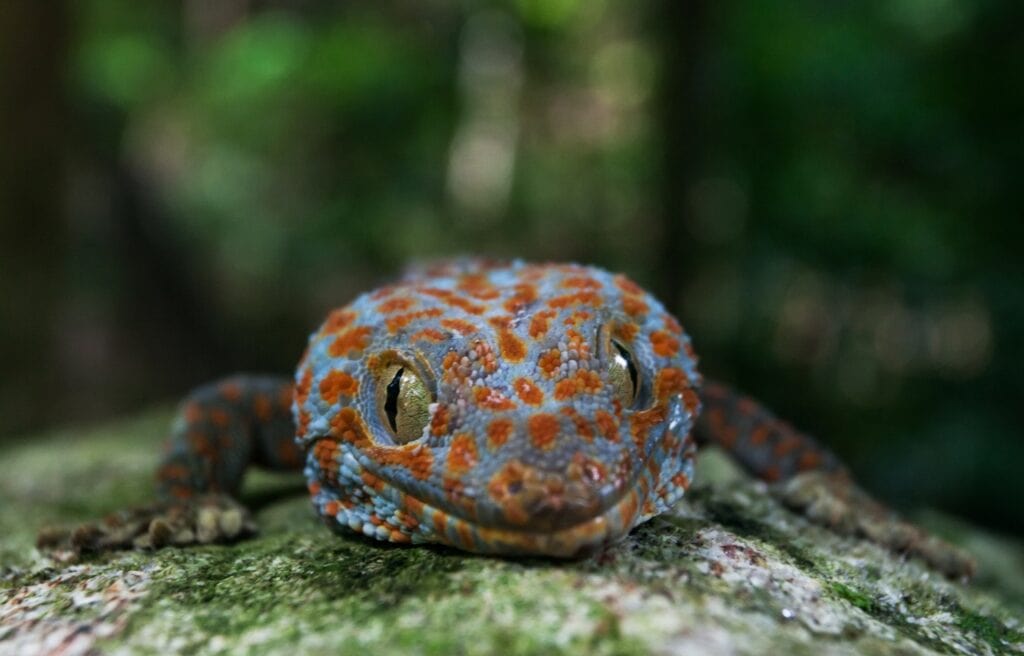
It’s important to remember that none of the lizards on this list will attack unprovoked, aside from alligators.
Nearly all bites or injuries result from trying to catch or handle a wild lizard. Unless cornered, lizards will always choose to run away before deciding to stand and fight.
Alligators are a different story. Gators are curious creatures, and some Florida gators were once domestic, so they may not have a fear of humans.
In rare cases, alligators will approach people from a sense of curiosity or belief that people will feed them.
Alligators will sometimes attack unprovoked because they mistake others for food. For example, when a gator hears splashing in the water, they might think tasty prey slipped into its territory.
Whatever the case, alligator attacks are rare. As long as you keep your distance, respect their space, and stay out of bodies of water that might have gators, you have nothing to fear from these prehistoric creatures.
The lizards on this list want to be left alone. If they bite, it’s almost always out of self-defense.
You may also like: Cold-Blooded Animals Listed: The Coolest Creatures In The World, Literally!
FAQs
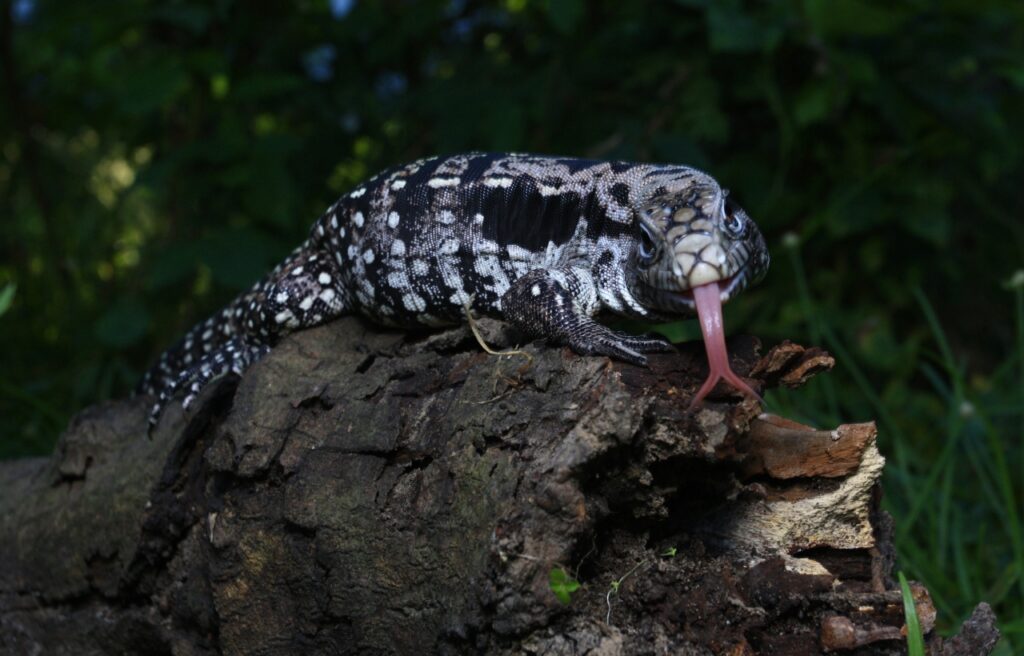
Are Florida lizards poisonous to humans?
Nope! No lizard in Florida is poisonous to humans.
What lizards are poisonous?
The United States has no poisonous lizards, but we have a venomous one. The gila monster (Heloderma suspectum) is a large, black, and orange lizard that lives in the deserts of Arizona and New Mexico.
Gila monster bites are flushed with venom, which helps them take down prey. Bites from them are said to be extremely painful. Luckily, gila monsters aren’t usually aggressive.
Are Florida geckos poisonous?
No, Florida geckos are not poisonous. Aside from the possibility of being bitten, the geckos that live in Florida are entirely harmless.
In fact, geckos are helpful creatures to have around the outside of your home. They’re like little exterminators, eating insects and keeping bugs away from doors and windows at night.
Do Florida lizards carry diseases?
Yes! Lizards may be carriers of salmonella, an infectious disease that can spread easily between reptiles and humans. Some studies indicate that 77% of lizards carry some type of salmonella bacteria.
You may also like:
Want to learn more about lizards in Florida and elsewhere? Check out the articles below!

Lizards in Florida | Lizards in North Carolina | Lizards in California | Geckos in Florida | Anoles in Florida








